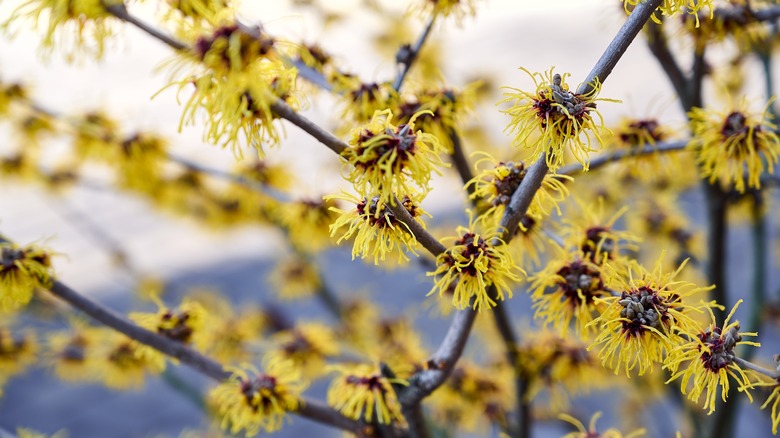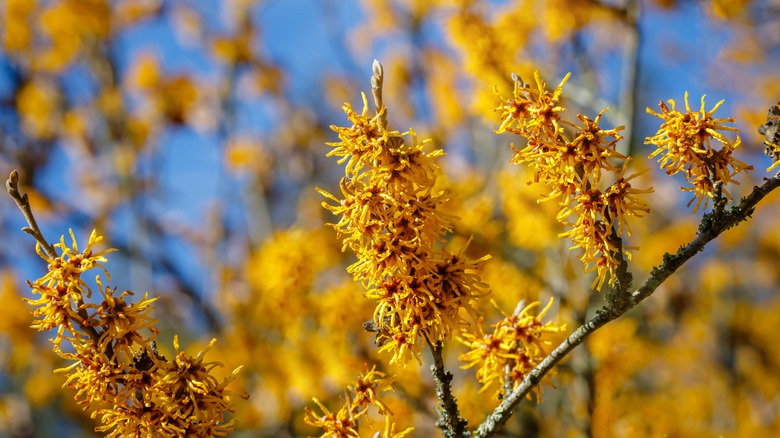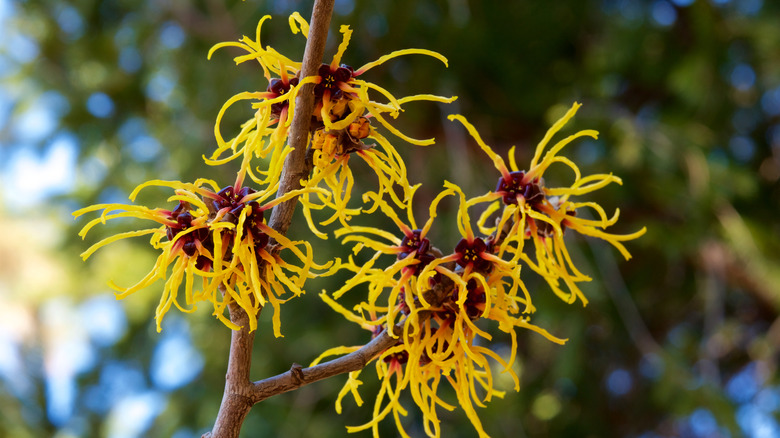Here's Where You Should Plant Witch Hazel In Your Garden For The Best Growth
Witch hazel is a lovely fragrant shrub or small tree that you might like to add to your garden. You'll find that witch hazel is deer-resistant and that most deer typically won't touch this gorgeous autumn plant, although this may depend on the season. You can enjoy the colorful foliage and the stunning winter flowers uninterrupted. Witch hazels are deciduous, which means they lose their leaves in the fall. But the best part is that once they've dropped their leaves, the trees will be covered with gorgeous, scented flowers in fall and through most of winter. When choosing the right spot in your garden to grow any of these witch hazel plants, you need to consider their native habitat, as this will give you a hint as to the plant's preferred growing conditions. Both native and non-native witch hazels can be grown in full sun to part shade, but this will depend on the individual species.
There are four major witch hazel species that you can grow, as well as numerous cultivars that have been bred by plant growers. Two of the major species (Hamamelis virginiana L. and Hamamelis vernalis) are native to the U.S. while non-native species include the Chinese witch hazel (Hamamelis mollis) and the Japanese witch hazel (Hamamelis japonica). Let's take a closer look at these four major species to determine exactly where they will grow best in your garden.
Choose the right spot in your garden for native witch hazel species
American witch hazel or common witch hazel, grows in both the Southeast and Northeast of the country. It naturally grows in forests as an understory plant and can be grown in zones 3 through 9. Ideally, you want to select a sunny to semi-shaded spot in your garden. As a bonus, you'll find that this is one of the most fragrant trees that'll make your garden smell better than ever. If you have tall deciduous trees in your garden, you can plant American witch hazel under another shrub or tree. This means it will get plenty of sunlight in the fall and winter to show off those magnificent flowers. According to the North Carolina Extension, this plant also does well when planted as a hedge or to provide some lovely shade in the summer. The soil should be fairly moist, well draining, and acidic with plenty of organic matter.
Vernal witch hazel naturally grows along streams and in wetlands. This means that it can be planted in a sunny spot in your garden. It will handle a little shade from overhead trees and grows well in zones through 8. Any low-lying spots in your garden would be ideal for planting vernal witch hazel as this plant does like a little more moisture, being a wetland species. The soil should be moist, free-draining, slightly acidic to neutral, and have lots of organic matter.
Where to plant non-native witch hazel in your garden
Chinese witch hazel grows naturally in the forests of eastern and central China. It has strongly perfumed flowers and grows well in a semi-shaded spot in zones 5 through 8. It needs moist, slightly acidic soil that contains organic matter. This species can be planted under taller trees to give the plant some shade in summer as the leaves can be scorched by the hot sun.
Japanese witch hazel can be found growing in the mountain areas of Japan. It will grow happily in full sun or partial shade in zones 5 through 8. The soil should be well-drained, slightly acidic, with lots of organic matter. You can plant this as a woodland border or a lovely hedge in your garden. Because it does well in sunny spots, it can be planted as a specimen tree to provide shade in the summer.
While all witch hazel species prefer moist soils rich in organic matter, they will also adapt to a range of soil types and will even grow in heavier clay soils. Remember to keep your witch hazel watered during dry spells and add some mulch around the base of the plant to retain moisture in the soil. If you're new to mulching, you might want to learn how to choose the best type of mulch for your garden for the different shrubs and trees that you're growing. For witch hazels, shredded bark is often the best mulch to use.


